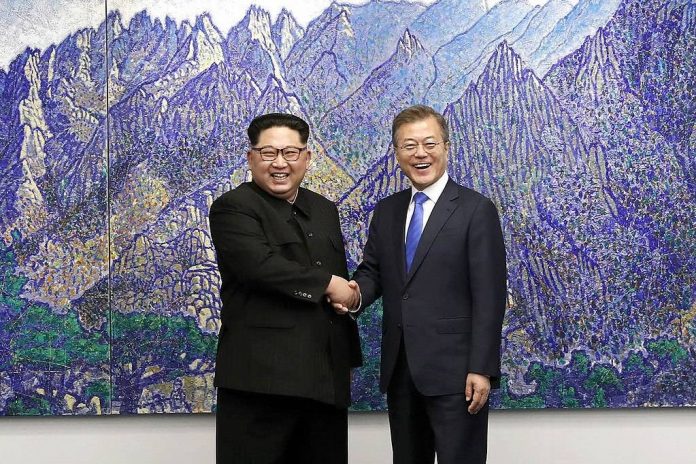The cycle of provocations on the Korean Peninsula, particularly caused by North Korea’s need to step up the escalatory ladder can be understood through the timing of those provocations. While South Korea and North Korea have not exchanged firing shots in 70 years, the Korean War that started in 1950 never officially ended due to technicalities. The Korean Peninsula has managed to somewhat thrive because of a détente. The pseudo peace that has existed between the two Koreas was influenced by July 27, 1953, the Korean Armistice Agreement that stopped direct warfare but did not technically end the war.
For the past 7 decades, the Armistice Agreement which only paved the way for a ceasefire has managed to hold water due to cooperation from both parties, but it failed to pave the way for a peace treaty. Thus, the détente between North Korea and South Korea continuously finds itself on shaky grounds if one party chooses to escalate the already fragile foundation of the 1953 Korean Armistice Agreement. The events of the first weeks of June 2020 have only proven that the Korean Peninsula cessation of hostilities through a long-lasting peace is a long way from being attained. If North Korea continues engaging in a foreign policy grounded in brinkmanship the peace on the Korean Peninsula will consistently be at risk because triggers or pressures might lead Pyongyang to act contra the peace maintenance apparatus.
The latest standoff between the two Koreas emanates from anti-Pyongyang leaflets that are being sent by defectors in Seoul across to North Korea by using makeshift balloons that can fly over the heavily fortified border. Kim Jong-un, the North Korean leader has interpreted these tactics to spread anti-Kim rhetoric as a direct threat to his authoritarian rule of the ‘hermit kingdom’. It should not come as a surprise that the acts by the North Korean defectors have led to veiled threats by the North’s Supreme Leader Kim Jong-un of vowing its “iron will” to punish South Korea. The absolute power that Kim Jong-un wields over the government and day to day life in North Korea means that he controls the type of information the North Koreans get about the government. As a heavily censored regime, all information that flows in and out of North Korea should be approved by his government to avoid the possibility of outside forces presenting a threat to the survival and propaganda machine of the Kim family. Thus, the Human Rights Watch lists North Korea as one of the most heavily censored countries in the world with state-run media that acts as a mouthpiece for the Kim regime.
Rodong Sinmun, the official newspaper of the Central Committee of the Workers’ Party of Korea, said South Korea’s recent actions against the North was “a challenge and a declaration of war against us.” However, the question arises of whether North Korea’s threats to cut off all communication lines with South Korea because of the leaflets should be seen as monolithic. It could be argued that the speculative news surrounding the North Korean Supreme Leader’s health is aiding to North Korea’s decisions since the May 23, 2020 meeting of the Workers’ Party of Korea Central Military Commission (CMC), in which Kim Jong-un set forth new policies to increase the nation’s nuclear deterrence. Arguably Kim Jong-un has been increasingly feeling pressured to assert his power and authority over the regime to showcase strength. Escalation of tension with Seoul and the United States are the most common tactics that he would revert to achieve this. It has been one of North Korea’s tactic to create an enemy to coalesce support behind the Supreme Leader within the regime while using tactics that could equally threaten peace on the Korean Peninsula. History has proven that the ‘hermit kingdom’s belligerent tactics influenced by the Juche, Songun, and Byung Ji ideologies of the need to have an enemy or create an existential threat have been part of North Korea since its inception. Considering that North Korea has used the creation of an enemy for regime survival for the past seven decades, these antics will always present a threat to the détente that exists on the Korean Peninsula.
North Korea’s decision to cease all communication with Seoul does not only take back the gains that had happened more than two years ago when the two Koreas formally opened hotlines for direct communication but it illustrates the fragility of the Korean relations. While in the past the South Korean leaders have been conciliatory when it comes to Pyongyang, they have not quite received the same courtesy. The relationship has been more one-sided due to Pyongyang’s unwillingness to offer equal concessions and hold on to them. Had the relationship between the two Koreas been equal when it comes to adherence with concessions the fragility of the détente on the Korean Peninsula would not still be a constant topic of discussion? While North Korea remains a very survey actor, its motives for choosing to use a more confrontational approach with South Korea should not be underestimated. However, this is not to say Kim Jong-un will wage a full-blown war against President Moon Jae-in as suggested by the threats but it should be interpreted as a long-term strategy by Kim Jong-un to hold South Korea for ransom in future negotiations. In other words, Kim Jong-un realizes that South Korea eventually bends to his bidding to maintain inter-Korean peace.
The Achilles heel for South Korea remains the idea of a possible unified Korea based on the principles of the Sunshine Policy or Engagement Policy that was formulated by the former president of South Korea Roo Moo-hyun. Such an Achilles heel has not gone unnoticed by Kim because he continues to use it against South Korea. As long as South Korea foresees a possible unification of the two Koreas, it would be close to impossible for the Blue House to address North Korea’s escalatory antics that threaten the peace on the Korean Peninsula in a manner that would discourage Kim’s regime from resorting to escalatory measures when it suites him. North Korean experts on the other hand are pointing out that Kim Jong-un’s threats should not lead South Korea to prosecute North Korean defectors from continuing with sending leaflets across the border. After South Korea said it would take legal action against two organizations that conduct such operations because Kim Jong-un is simply adopting a tactic from the North Korean international relations playbook to create urgency in delaying talks.
Further threats that have been made by Kim Yo-jong, the powerful sister of the North Korean leader and first vice department director of the party’s Central Committee, to cancel a military tension-reducing agreement made during the 2018 inter-Korean summit, and to disband the Kaesong Industrial Complex have been used before in instances where Pyongyang is looking for leverage against South Korea. There is broad consensus that moving up the escalatory ladder even by targeting points such as the Kaesong Industrial Complex that serves both the North and South are an example of the fragile détente that exists between the two Koreas. However, such threats should still be a precursor or as laying the foundation for things to come in terms of the North-South negotiations. While a peaceful Korean Peninsula remains an idealistic aspiration, it should also be acknowledged that the détente between the parties is only temporary until Kim’s regime decides to step up on the escalatory ladder. Its methodical brinkmanship can be described as opportunistic and calculated. Therefore, the détente rules might apply for South Korea to strictly make sure they stay in place but for North Korea, if for any reason it feels slighted or the Kim family wants to assert its power — escalation, provocations, and threats will always triumph instead of maintaining a détente on the Korean Peninsula.
The views and opinions expressed in this article are those of the author.

Ian Fleming has an M.A. & B. A. in International Politics by the University of South Africa. He has been published in Asian Journal of Peace. His areas of research include nuclear diplomacy, cybersecurity, and foreign policy. He is currently serving as the Editor in Chief for IAPSS journal ADV and is the Chairperson of the IAPSS SRC on Conflict Security & Crime. Furthermore, he is a member of the Comprehensive Nuclear Test Ban Treaty Organization Youth Group. In addition, he is a board member of the British American Security Information Council’s Emerging Voices Network.


